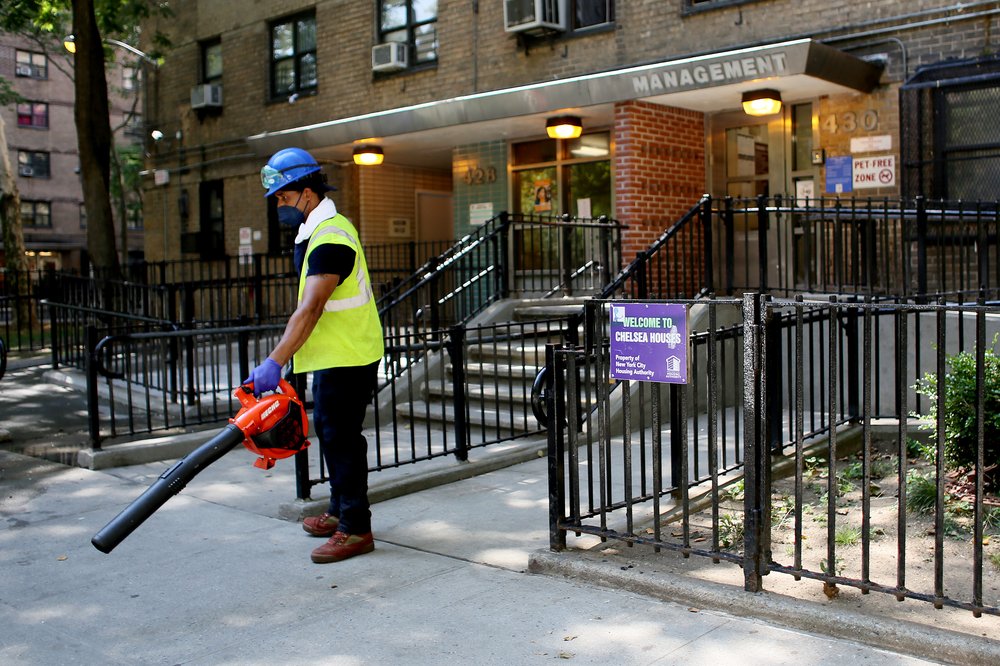2,000 NYCHA apartments in Manhattan to be torn down under controversial redevelopment plan
Oct. 30, 2024, 4 p.m.
The public housing authority’s board voted to approve a plan to build new apartments for roughly 4,500 tenants, alongside thousands of new market-rate units.

A controversial plan to tear down and replace thousands of public housing apartments in Manhattan is one step closer to reality following a key vote on Wednesday.
The New York City Housing Authority's board approved the proposal to replace 18 buildings across the Fulton and Chelsea-Elliott Houses — where around 4,500 people live — and also allow for thousands of additional market-rate units on the two campuses.
The plan would be the largest such replacement project in the history of NYCHA, which runs the nation’s largest public housing system but has faced decades of disinvestment compounded by mismanagement and scandals. The agency has turned to private developers and managers to take over building operations through a program that changes the source of federal funding for the apartments.
The demolition-and-replacement proposal has earned support from Mayor Eric Adams and members of NYCHA’s board. It represents a major change in how the city’s public housing is managed and developed, with tenants set to move into new apartments once construction is completed in phases over the next seven years.
“While it’s taken a long time to get here and it’s going to take a long time to move on, this is a really important moment in the history of NYCHA’s transformation,” said Jamie Rubin, the board's chair, at the board’s meeting on Wednesday morning. “The only way to restore NYCHA to the status that it once had, which is the glory of the United States public housing system, is to reinvest in the buildings at scale.”
Under the plan, two private developers — Related Companies and Essence — would erect six new apartment buildings and move most of the existing tenants into them in phases over the next seven years. The current structures, which contain more than 2,000 units, would then be torn down. About 120 tenants, including residents of a building specifically for seniors, would have to move out before the new apartments are constructed.
Construction on the first two NYCHA buildings, which can be built within current zoning regulations, is expected to begin after the U.S. Department of Housing and Urban Development approves a required environmental review next year, according to the housing authority. The agreement between NYCHA and the developers outlines key milestones and phasing timelines for the project.
Tenant association leaders support the plan and say it’s necessary to address their aging homes.
“I invite anyone who doesn’t live in Fulton: Come stay in Fulton and you’ll see how we’re living, how disgusting it is,” said Miguel Acevedo, president of the Fulton Houses Tenant Association.
But concerns about potential displacement have fueled some of the opposition to the plan, as residents and their allies worry the tenants won’t be able to return. Other opponents say they fear losing their current rights to pay a percentage of their income toward rent and pass on apartments to family members. They presented the board with a petition signed by 939 residents opposing the demolition plan.
“The demolition proposal is being forced on us. It’s what you want,” Elliott Houses tenant Celines Miranda told the board. “It’s obvious what the true motive is for this demolition: It’s a land grab.”
Officials from NYCHA, Essence and Related have sought to allay residents’ concerns by promising that the tenants will retain their same lease rights throughout the project, though the tenants may be forced to move into units that are smaller than their current apartments.
Many of the tenants who end up displaced from the buildings before the new ones are ready would have the opportunity to move into vacant apartments on the two campuses, NYCHA Vice President Jonathan Gouveia told the board on Wednesday.
“Any household that is temporarily relocated off site will have the right to return to their development once the associated NYCHA replacement building is complete,” he said.
The proposal would also allow the two developers to construct around 3,500 additional apartments on the sites. A portion of the units would be reserved for low- and middle-income tenants, according to the plan.
Any new market-rate housing in one of the nation’s most expensive ZIP codes could be a bonanza for the developers, as some of the plan's opponents have pointed out. But its supporters say the additional proposed apartments are crucial for addressing the city’s housing shortage.
The replacement plan re-emerged last year after a tenant-led task force initially rejected the demolition concept in 2021. Essence CEO Jamar Adams told Gothamist last year that his company began calculating the cost of renovations and determined they would roughly equal the cost of building from scratch.
NYCHA surveyed residents of the Fulton and Chelsea-Elliott Houses last year about whether they would support replacing the current units. Most of the 950 respondents said they did.
The housing agency estimates it needs $78 billion for repairs and renovations across its hundreds of developments, according to its most recent budget estimate. NYCHA campuses are officially home to more than 360,000 New Yorkers, though housing experts say the true number of residents who are not listed on leases is likely far higher.
This story has been updated with additional information from NYCHA.
NYC public housing tenants make last-ditch push to stop demolition in Chelsea Report: NYCHA 'mishandled' water issues at East Village public housing complex in 2022 About 70 NYC public housing employees arrested in bribery probe, federal officials say